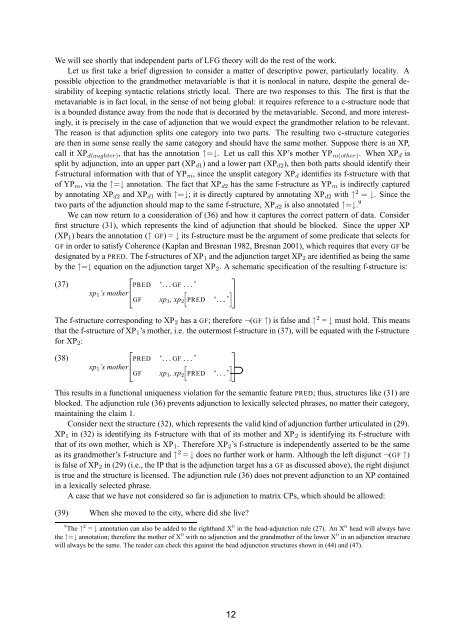Proceedings of the LFG 02 Conference National Technical - CSLI ...
Proceedings of the LFG 02 Conference National Technical - CSLI ...
Proceedings of the LFG 02 Conference National Technical - CSLI ...
You also want an ePaper? Increase the reach of your titles
YUMPU automatically turns print PDFs into web optimized ePapers that Google loves.
We will see shortly that independent parts <strong>of</strong> <strong>LFG</strong> <strong>the</strong>ory will do <strong>the</strong> rest <strong>of</strong> <strong>the</strong> work.<br />
Let us first take a brief digression to consider a matter <strong>of</strong> descriptive power, particularly locality. A<br />
possible objection to <strong>the</strong> grandmo<strong>the</strong>r metavariable is that it is nonlocal in nature, despite <strong>the</strong> general desirability<br />
<strong>of</strong> keeping syntactic relations strictly local. There are two responses to this. The first is that <strong>the</strong><br />
metavariable is in fact local, in <strong>the</strong> sense <strong>of</strong> not being global: it requires reference to a c-structure node that<br />
is a bounded distance away from <strong>the</strong> node that is decorated by <strong>the</strong> metavariable. Second, and more interestingly,<br />
it is precisely in <strong>the</strong> case <strong>of</strong> adjunction that we would expect <strong>the</strong> grandmo<strong>the</strong>r relation to be relevant.<br />
The reason is that adjunction splits one category into two parts. The resulting two c-structure categories<br />
are <strong>the</strong>n in some sense really <strong>the</strong> same category and should have <strong>the</strong> same mo<strong>the</strong>r. Suppose <strong>the</strong>re is an XP,<br />
call it XP d(aughter), that has <strong>the</strong> annotation ↑=↓. Let us call this XP’s mo<strong>the</strong>r YP m(o<strong>the</strong>r). When XPd is<br />
split by adjunction, into an upper part (XPd1) and a lower part (XPd2), <strong>the</strong>n both parts should identify <strong>the</strong>ir<br />
f-structural information with that <strong>of</strong> YPm, since <strong>the</strong> unsplit category XPd identifies its f-structure with that<br />
<strong>of</strong> YPm, via <strong>the</strong> ↑=↓ annotation. The fact that XPd2 has <strong>the</strong> same f-structure as YPm is indirectly captured<br />
by annotating XPd2 and XPd1 with ↑=↓; it is directly captured by annotating XPd2 with ↑ 2 = ↓. Since <strong>the</strong><br />
two parts <strong>of</strong> <strong>the</strong> adjunction should map to <strong>the</strong> same f-structure, XPd2 is also annotated ↑=↓. 9<br />
We can now return to a consideration <strong>of</strong> (36) and how it captures <strong>the</strong> correct pattern <strong>of</strong> data. Consider<br />
first structure (31), which represents <strong>the</strong> kind <strong>of</strong> adjunction that should be blocked. Since <strong>the</strong> upper XP<br />
(XP1) bears <strong>the</strong> annotation (↑ GF) = ↓ its f-structure must be <strong>the</strong> argument <strong>of</strong> some predicate that selects for<br />
GF in order to satisfy Coherence (Kaplan and Bresnan 1982, Bresnan 2001), which requires that every GF be<br />
designated by a PRED. The f-structures <strong>of</strong> XP1 and <strong>the</strong> adjunction target XP2 are identified as being <strong>the</strong> same<br />
by <strong>the</strong> ↑=↓ equation on <strong>the</strong> adjunction target XP2. A schematic specification <strong>of</strong> <strong>the</strong> resulting f-structure is:<br />
(37)<br />
⎡<br />
PRED<br />
xp1’s mo<strong>the</strong>r⎣<br />
GF<br />
‘. . . GF . . . ’<br />
�<br />
xp1, xp2 PRED<br />
⎤<br />
�⎦<br />
‘. . . ’<br />
The f-structure corresponding to XP2 has a GF; <strong>the</strong>refore ¬(GF ↑) is false and ↑2 = ↓ must hold. This means<br />
that <strong>the</strong> f-structure <strong>of</strong> XP1’s mo<strong>the</strong>r, i.e. <strong>the</strong> outermost f-structure in (37), will be equated with <strong>the</strong> f-structure<br />
for XP2:<br />
⎡<br />
⎤<br />
(38)<br />
PRED ‘. . . GF . . . ’<br />
xp1’s mo<strong>the</strong>r⎣<br />
�<br />
�⎦<br />
GF xp1, xp2 PRED ‘. . . ’<br />
This results in a functional uniqueness violation for <strong>the</strong> semantic feature PRED; thus, structures like (31) are<br />
blocked. The adjunction rule (36) prevents adjunction to lexically selected phrases, no matter <strong>the</strong>ir category,<br />
maintaining <strong>the</strong> claim 1.<br />
Consider next <strong>the</strong> structure (32), which represents <strong>the</strong> valid kind <strong>of</strong> adjunction fur<strong>the</strong>r articulated in (29).<br />
XP1 in (32) is identifying its f-structure with that <strong>of</strong> its mo<strong>the</strong>r and XP2 is identifying its f-structure with<br />
that <strong>of</strong> its own mo<strong>the</strong>r, which is XP1. Therefore XP2’s f-structure is independently asserted to be <strong>the</strong> same<br />
as its grandmo<strong>the</strong>r’s f-structure and ↑ 2 = ↓ does no fur<strong>the</strong>r work or harm. Although <strong>the</strong> left disjunct ¬(GF ↑)<br />
is false <strong>of</strong> XP2 in (29) (i.e., <strong>the</strong> IP that is <strong>the</strong> adjunction target has a GF as discussed above), <strong>the</strong> right disjunct<br />
is true and <strong>the</strong> structure is licensed. The adjunction rule (36) does not prevent adjunction to an XP contained<br />
in a lexically selected phrase.<br />
A case that we have not considered so far is adjunction to matrix CPs, which should be allowed:<br />
(39) When she moved to <strong>the</strong> city, where did she live?<br />
9 The ↑ 2 = ↓ annotation can also be added to <strong>the</strong> righthand X 0 in <strong>the</strong> head-adjunction rule (27). An X 0 head will always have<br />
<strong>the</strong> ↑=↓ annotation; <strong>the</strong>refore <strong>the</strong> mo<strong>the</strong>r <strong>of</strong> X 0 with no adjunction and <strong>the</strong> grandmo<strong>the</strong>r <strong>of</strong> <strong>the</strong> lower X 0 in an adjunction structure<br />
will always be <strong>the</strong> same. The reader can check this against <strong>the</strong> head adjunction structures shown in (44) and (47).<br />
12





